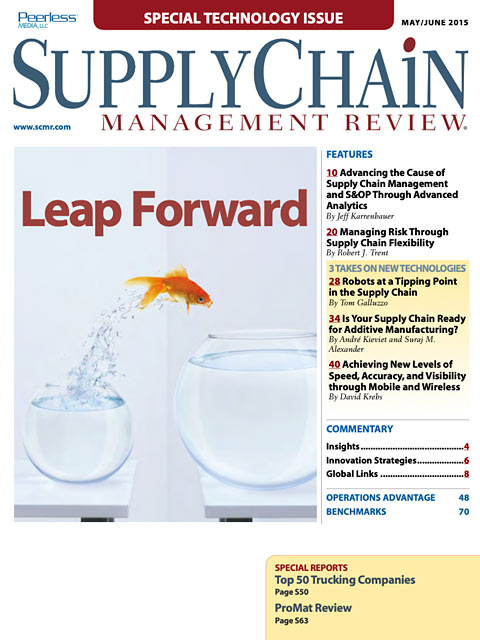Sorry, but your login has failed. Please recheck your login information and resubmit. If your subscription has expired, renew here.
May-June 2015
As supply chain managers we are challenged year in and year out to figure out new, innovative ways to improve our operations. We have to translate educated guesses about what’s next into new investments in our processes. Such may be the case with robotics, 3D printing and additive manufacturing, and investments in new mobile technologies. However, successful planning, including planning for risk, resiliency, and flexibility, can help prepare you for whatever is next. Browse this issue archive.Need Help? Contact customer service 847-559-7581 More options
“If man ever flies, it will not be within our lifetime, not within a thousand years.”—Wilbur Wright, 1901
Just two years after making the above comment to his brother Orville, the Wrights made the world’s first powered aircraft flight. How could someone so close to the tipping point, arguably the most influential person in aeronautical history, not know that success was within reach?
I experienced a similar phenomenon in my own career in robotics when I was a graduate student at the University of Florida. In 2004, the Defense Advanced Research Projects Agency (DARPA), the government group best known for fostering the Internet, challenged the robotics world to race unmanned vehicles 150 miles through the Mojave Desert. No one had ever built a robot that could drive by itself through that much off-road terrain. It was called the DARPA Grand Challenge.
My professor decided that our research lab would compete in the race. Over 100 teams attempted the challenge; only 15 were able to get robots to the starting line, and none made it through more than five percent of the course. It was a complete failure. Most robots veered off track and crashed, some got stuck and ran their engines until catching fire. Ours plowed itself through barbed wire until it tangled itself to death. We made the most of the experience, but we couldn’t help but feel defeated that day. I remember saying to my teammates that it would be many years before anyone would complete the challenge. No one disagreed.
 |
This complete article is available to subscribers
only. Click on Log In Now at the top of this article for full access. Or, Start your PLUS+ subscription for instant access. |
SC
MR
Sorry, but your login has failed. Please recheck your login information and resubmit. If your subscription has expired, renew here.
May-June 2015
As supply chain managers we are challenged year in and year out to figure out new, innovative ways to improve our operations. We have to translate educated guesses about what’s next into new investments in our… Browse this issue archive. Access your online digital edition. Download a PDF file of the May-June 2015 issue.
 |
Download Article PDF |
“If man ever flies, it will not be within our lifetime, not within a thousand years.”—Wilbur Wright, 1901
Just two years after making the above comment to his brother Orville, the Wrights made the world’s first powered aircraft flight. How could someone so close to the tipping point, arguably the most influential person in aeronautical history, not know that success was within reach?
I experienced a similar phenomenon in my own career in robotics when I was a graduate student at the University of Florida. In 2004, the Defense Advanced Research Projects Agency (DARPA), the government group best known for fostering the Internet, challenged the robotics world to race unmanned vehicles 150 miles through the Mojave Desert. No one had ever built a robot that could drive by itself through that much off-road terrain. It was called the DARPA Grand Challenge.
My professor decided that our research lab would compete in the race. Over 100 teams attempted the challenge; only 15 were able to get robots to the starting line, and none made it through more than five percent of the course. It was a complete failure. Most robots veered off track and crashed, some got stuck and ran their engines until catching fire. Ours plowed itself through barbed wire until it tangled itself to death. We made the most of the experience, but we couldn’t help but feel defeated that day. I remember saying to my teammates that it would be many years before anyone would complete the challenge. No one disagreed.
 |
SUBSCRIBERS: Click here to download PDF of the full article. |
SC
MR

More Robotics
- Humanoid robots’ place in an intralogistics smart robot strategy
- Mobile Robots Leading the Hype Battle with Drones
- Generative AI, Robotics and Automation: Supply Chain Friends or Foes?
- MassRobotics announces winner of Robotics Medal, names Rising Star
- Let’s Talk Mobile Robots: Three Real-World Applications for Warehouse and Manufacturing
- Industry first: One million robots on the job in automotive
- More Robotics
Latest Podcast

 Explore
Explore
Software & Technology News
- AI, virtual reality is bringing experiential learning into the modern age
- Humanoid robots’ place in an intralogistics smart robot strategy
- Tips for CIOs to overcome technology talent acquisition troubles
- Game on: Rethinking change management for the digital era
- Predicting stockouts: Enhancing FMCG resilience through data-driven insights
- Top Performers Investing in, Benefitting from AI
- More Software & Technology
Latest Software & Technology Resources

Subscribe

Supply Chain Management Review delivers the best industry content.

Editors’ Picks





